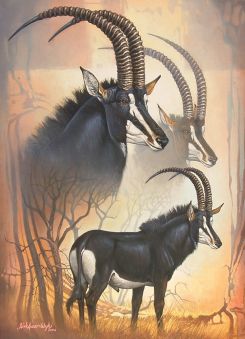Sable Antelope
| Species | bovine |
| No. Appearing | 4–40 |
| Behaviour | herd (loose) |
| Range | desert, steppe, woodland |
| Size | 4 ft. at shoulder |
| Weight | 510 lbs. |
| Intelligence | 1 |
| Armour Class | 7 |
| Hit Dice | 2 |
| Action Points | 8 |
| Max. Stride | 20 |
| THAC0 | 20 |
| Hp/Die | d10 |
| Attack Forms | horn butt |
| Damage | 2–8 |
| Special Attacks | charge |
Sable antelope are large hoofed mammals whose range extends from southern Africe to the Indian Subcontinent; they are often confused with the bluebuck, which looks similar. They prefer wooded areas throughout the savanna, but can be found in semi-deserts such as the Thar Desert or in southern Arabia. The name comes from the black colour of their dark coat; their skins are prized for use as floor coverings and shield making.
Behaviour
Ordinarily docile, the sable antelope will give ground when approached, keeping a distance of 20-50 hexes. They'll fight if pressed. A missile hit causes the antelope to scream, which panics the herd into a run.
Antelope are able to run at 35 miles per hour, which translates to 15 hexes per action point.
Sable antelopes rut during the late dry season, for 2-3 months — and during this time they will be very aggressive. Males will fight among themselves to become the lead male, but these fights rarely end in injury. When antelope encounter predators, the herd will tighten together to confront the threat. Several antelope will fight and even kill before giving ground. If the number of enemy outnumbers the antelopes, they will break into a run, typically covering a distance of about half a mile before stopping. If they equal or outnumber the enemy, however, they will aggressively charge until it is clear they are being left alone.
When a herd grows too large, it will divide into smaller groups of cows and their young. These groups form new herds, once again with only one adult bull. Additional males will move along nearby and keep to themselves in groups of 3-12.
See Bestiary
